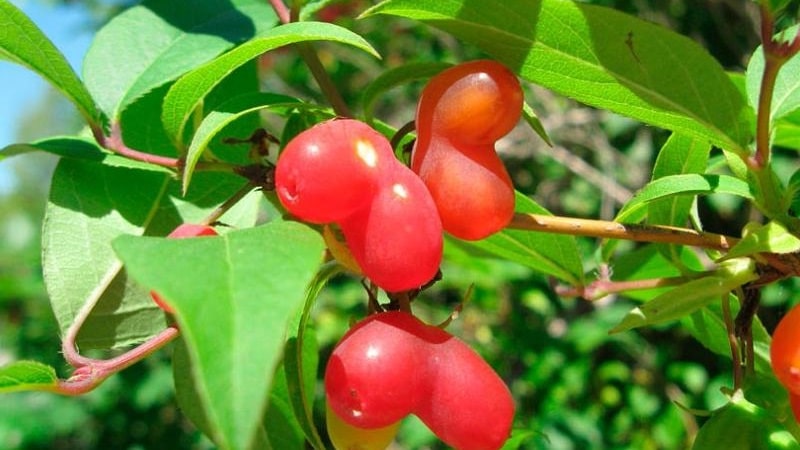Red honeysuckle - edible or not
Honeysuckle with red berries is known as a poisonous or at least unedible plant, widespread in the forests of Siberia and the gardens of Europe. However edible varieties also exist. The berries of such crops have excellent taste and are suitable for consumption.
In this article we will tell you whether red honeysuckle is edible or not, where it grows and what it looks like, how red edible honeysuckle differs from blue one. In addition, we will introduce you to the Finnish edible variety Sindischen.
Honeysuckle with red berries - can they be eaten?
Red honeysuckle is a perennial shrub that grows wild in the Far East, northern Korea, China, and Japan.
Many people, out of ignorance, think that only blue fruits are suitable for food, and scarlet berries (wolfberries) are poisonous. In fact, some varieties produce bright red, edible, juicy berries with a pleasantly sweet and refreshing taste and barely noticeable bitterness. The fruits of such crops are used for fresh consumption and the preparation of jams, preserves, tinctures, and compotes.

In addition, the medium-sized spreading shrub has a decorative function. During flowering, the plant looks amazing and can improve any area. Landscape designers advise planting the red variety for vertical gardening. The shrub combines well with climbing roses and conifers.
Description of the edible red Finnish honeysuckle Sindischen
Finnish Sindishen is a tall shrub that is popular with gardeners. Tall branches with dense foliage are not afraid of frost and drought. In regions with a mild climate, Sindishen remains green until spring.
Reference. Graceful bushes with a dense crown that do not shed leaves are often used to create hedges.
The berries are medium-sized, double, fused at the top in the shape of a heart. The skin and pulp are painted scarlet. The fruits have a pleasant bitter-sweet taste and contain small seeds.
Sindishen is one of the most delicious and healthy edible varieties. The fruits contain a record amount of vitamins and microelements.
Differences between red edible honeysuckle and blue one
Blue and scarlet berries equally useful. Their color is determined by the main pigment of the fruit. Red and blue colors are formed by anthocyanins - strong antioxidants that suppress inflammatory processes, lower cholesterol levels and strengthen the vascular wall.
The chemical composition of fruits of different varieties is similar, but scarlet berries contain more vitamins C, E and group B.

Red honeysuckle is more frost-resistant and bears fruit in the cold northern and eastern regions of the country. The unpretentiousness and magnificent appearance of the shrub allows it to be grown as a berry crop and as an ornamental plant.
The scarlet variety of the crop differs from the blue one in that its berries are stored on the shoots and do not fall off under any conditions. In addition, they do not rot and retain their taste for a long time.
It is worth paying attention to the shape of the fruit:
- in red Sindishen they are paired in the form of a scarlet heart and contain small seeds, like grains of sand;
- blue berries have an elongated shape, reach 5 cm in length and contain almost no seeds.
Regarding taste characteristics:
- red fruits have a pleasant sweet, refreshing taste with a subtle bitterness;
- The taste of blue fruits depends on the variety: generally tender and pleasant, it can be sweet, sour-sweet, with or without an imperceptible bitterness.
Interesting things on the site:
What year after planting does honeysuckle bear fruit?
What kind of soil and drainage does honeysuckle like?
What can honeysuckle be planted next to and why is it important?
Conclusion
Contrary to popular belief, red honeysuckle is edible and contains more vitamins and minerals than the blue variety. The most popular variety is the Finnish edible Sindishen. The culture bears fruit with double heart-shaped berries, which have a pleasant sweet taste with a barely noticeable bitterness.
The pulp contains a small amount of small seeds, but they do not in any way affect the taste characteristics of the fruit. Red is grown as a fruit and berry bush for harvest, and is also used for vertical gardening of personal plots.